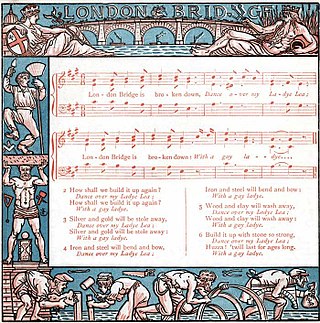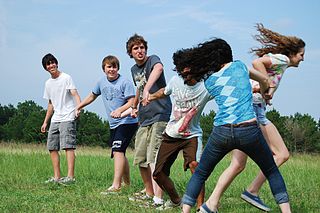
Folklore is the body of expressive culture shared by a particular group of people, culture or subculture. This includes oral traditions such as tales, myths, legends, proverbs, poems, jokes, and other oral traditions. This also includes material culture, such as traditional building styles common to the group. Folklore also encompasses customary lore, taking actions for folk beliefs, and the forms and rituals of celebrations such as Christmas, weddings, folk dances, and initiation rites.

A nursery rhyme is a traditional poem or song for children in Britain and other European countries, but usage of the term dates only from the late 18th/early 19th century. The term Mother Goose rhymes is interchangeable with nursery rhymes.

"London Bridge Is Falling Down" is a traditional English nursery rhyme and singing game, which is found in different versions all over the world. It deals with the dilapidation of London Bridge and attempts, realistic or fanciful, to repair it. It may date back to bridge-related rhymes and games of the Late Middle Ages, but the earliest records of the rhyme in English are from the 17th century. The lyrics were first printed in close to their modern form in the mid-18th century and became popular, particularly in Britain and the United States, during the 19th century.

A clapping game is a type of usually cooperative game which is generally played by two players and involves clapping as a rhythmic accompaniment to a singing game or reciting of a rhyme, often nursery rhymes. Clapping games are found throughout the world and similar games may be known throughout large areas with regional variation.

"Ring a Ring o' Roses", "Ring a Ring o' Rosie", or "Ring Around the Rosie", is a nursery rhyme, folk song and playground singing game. Descriptions first emerge in the mid-19th century, but are reported as dating from decades before, and similar rhymes are known from across Europe, with various lyrics. It has a Roud Folk Song Index number of 7925.

Red Rover is a team game played primarily by children on playgrounds, requiring 10+ players.

Children's street culture refers to the cumulative culture created by young children. Collectively, this body of knowledge is passed down from one generation of urban children to the next, and can also be passed between different groups of children. It is most common in children between the ages of seven and twelve. It is strongest in urban working-class industrial districts where children are traditionally free to "play outside" in the streets for long periods without supervision.

Hunt the thimble is a party game in which one person hides a thimble, or other small object, somewhere in the room, while all other players wait outside. When everyone comes back in, they race to locate the hidden object. The first to find it is the winner, and hides it for the next game.
A children's song may be a nursery rhyme set to music, a song that children invent and share among themselves or a modern creation intended for entertainment, use in the home or education. Although children's songs have been recorded and studied in some cultures more than others, they appear to be universal in human society.
"Tinker, Tailor" is a counting game, nursery rhyme and fortune telling song traditionally played in England, that can be used to count cherry stones, buttons, daisy petals and other items. It has a Roud Folk Song Index number of 802. It is commonly used by children in both Britain and America for "counting out", e.g. for choosing who shall be "It" in a game of tag.
"The Farmer in the Dell" is a singing game, nursery rhyme, folksong, and children's song. It probably originated in Germany and was brought to America by immigrants. From there, it spread to many other nations and is popular in a number of languages. It is Roud Folk Song Index number 6306.

"Pease Porridge Hot" or "Pease Pudding Hot" is an English children's singing game and nursery rhyme. It has a Roud Folk Song Index number of 19631.
A skipping rhyme, is a rhyme chanted by children while skipping. Such rhymes have been recorded in all cultures where skipping is played. Examples of English-language rhymes have been found going back to at least the 17th century. Like most folklore, skipping rhymes tend to be found in many different variations. The article includes those chants used by English-speaking children.

"Nuts in May" is a singing game played by children with the aim of pairing a boy and girl from within two teams of participants. It was first recorded in the second half of the 19th century and has Roud Folk Song Index 6308.
Iona Margaret Balfour Opie, and Peter Mason Opie were an English married team of folklorists who applied modern techniques to understanding children's literature and play, in studies such as The Oxford Dictionary of Nursery Rhymes (1951) and The Lore and Language of Schoolchildren (1959). They were also noted anthologists, assembled large collections of children's literature, toys, and games and were regarded as world-famous authorities on children's lore and customs.

Childlore is the folklore or folk culture of children and young people. It includes, for example, rhymes and games played in the school playground. The best known researchers of the field were Iona and Peter Opie.
The Folklore Society (FLS) is a registered charity under English law based in London, England for the study of folklore. Its office is at 50 Fitzroy Street, London home of the Royal Anthropological Institute of Great Britain and Ireland.

Duck, duck, goose is a traditional children's game often first learned in preschool or kindergarten. The game may be later adapted on the playground for early elementary students. The object of this game is to walk in a circle, tapping on each player's head until one is finally chosen; the chosen player must then chase the picker to avoid becoming the next picker.
"The Singing Street", is a short film made in 1950 in Edinburgh, Scotland and first shown in 1951. It was created by a group of teachers from Norton Park School, who filmed some of their pupils playing street games, accompanied by traditional children's songs, at various locations in the city. It documented an oral tradition which has all but vanished in the decades since it was made.
In and Out the Dusting Bluebells, also known as In and Out the Dusty or Dusky Bluebells, is a children's playground song and dance. The game is not thought to have formed until the early 20th century and although it enjoyed great popularity amongst girls during the 1960s and 1970s, its popularity had waned by the 2000s.













